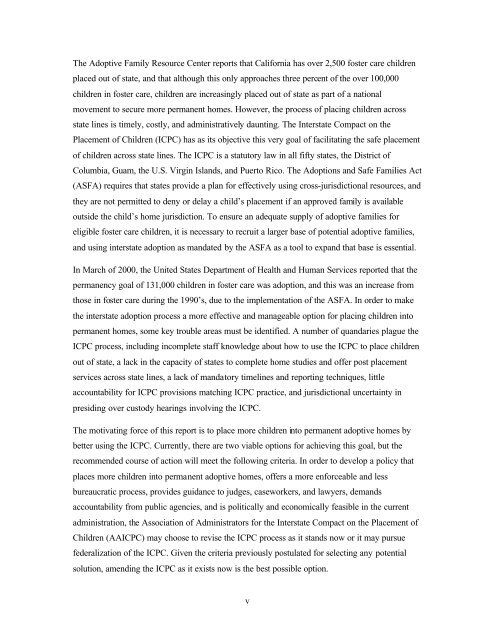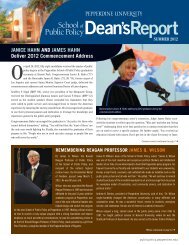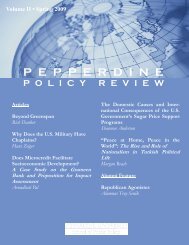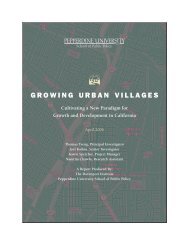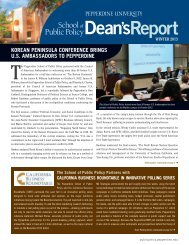Finding Permanent Homes for Adoptable Children - Pepperdine ...
Finding Permanent Homes for Adoptable Children - Pepperdine ...
Finding Permanent Homes for Adoptable Children - Pepperdine ...
Create successful ePaper yourself
Turn your PDF publications into a flip-book with our unique Google optimized e-Paper software.
The Adoptive Family Resource Center reports that Cali<strong>for</strong>nia has over 2,500 foster care children<br />
placed out of state, and that although this only approaches three percent of the over 100,000<br />
children in foster care, children are increasingly placed out of state as part of a national<br />
movement to secure more permanent homes. However, the process of placing children across<br />
state lines is timely, costly, and administratively daunting. The Interstate Compact on the<br />
Placement of <strong>Children</strong> (ICPC) has as its objective this very goal of facilitating the safe placement<br />
of children across state lines. The ICPC is a statutory law in all fifty states, the District of<br />
Columbia, Guam, the U.S. Virgin Islands, and Puerto Rico. The Adoptions and Safe Families Act<br />
(ASFA) requires that states provide a plan <strong>for</strong> effectively using cross-jurisdictional resources, and<br />
they are not permitted to deny or delay a child’s placement if an approved family is available<br />
outside the child’s home jurisdiction. To ensure an adequate supply of adoptive families <strong>for</strong><br />
eligible foster care children, it is necessary to recruit a larger base of potential adoptive families,<br />
and using interstate adoption as mandated by the ASFA as a tool to expand that base is essential.<br />
In March of 2000, the United States Department of Health and Human Services reported that the<br />
permanency goal of 131,000 children in foster care was adoption, and this was an increase from<br />
those in foster care during the 1990’s, due to the implementation of the ASFA. In order to make<br />
the interstate adoption process a more effective and manageable option <strong>for</strong> placing children into<br />
permanent homes, some key trouble areas must be identified. A number of quandaries plague the<br />
ICPC process, including incomplete staff knowledge about how to use the ICPC to place children<br />
out of state, a lack in the capacity of states to complete home studies and offer post placement<br />
services across state lines, a lack of mandatory timelines and reporting techniques, little<br />
accountability <strong>for</strong> ICPC provisions matching ICPC practice, and jurisdictional uncertainty in<br />
presiding over custody hearings involving the ICPC.<br />
The motivating <strong>for</strong>ce of this report is to place more children into permanent adoptive homes by<br />
better using the ICPC. Currently, there are two viable options <strong>for</strong> achieving this goal, but the<br />
recommended course of action will meet the following criteria. In order to develop a policy that<br />
places more children into permanent adoptive homes, offers a more en<strong>for</strong>ceable and less<br />
bureaucratic process, provides guidance to judges, caseworkers, and lawyers, demands<br />
accountability from public agencies, and is politically and economically feasible in the current<br />
administration, the Association of Administrators <strong>for</strong> the Interstate Compact on the Placement of<br />
<strong>Children</strong> (AAICPC) may choose to revise the ICPC process as it stands now or it may pursue<br />
federalization of the ICPC. Given the criteria previously postulated <strong>for</strong> selecting any potential<br />
solution, amending the ICPC as it exists now is the best possible option.<br />
v


